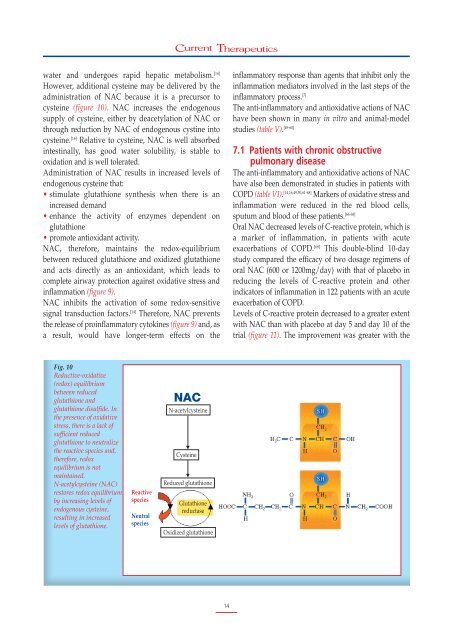Therapeutics
Role of N-Acetylcysteine
Role of N-Acetylcysteine
- No tags were found...
Create successful ePaper yourself
Turn your PDF publications into a flip-book with our unique Google optimized e-Paper software.
Current <strong>Therapeutics</strong><br />
water and undergoes rapid hepatic metabolism. [14]<br />
However, additional cysteine may be delivered by the<br />
administration of NAC because it is a precursor to<br />
cysteine (figure 10). NAC increases the endogenous<br />
supply of cysteine, either by deacetylation of NAC or<br />
through reduction by NAC of endogenous cystine into<br />
cysteine. [16] Relative to cysteine, NAC is well absorbed<br />
intestinally, has good water solubility, is stable to<br />
oxidation and is well tolerated.<br />
Administration of NAC results in increased levels of<br />
endogenous cysteine that:<br />
• stimulate glutathione synthesis when there is an<br />
increased demand<br />
• enhance the activity of enzymes dependent on<br />
glutathione<br />
• promote antioxidant activity.<br />
NAC, therefore, maintains the redox-equilibrium<br />
between reduced glutathione and oxidized glutathione<br />
and acts directly as an antioxidant, which leads to<br />
complete airway protection against oxidative stress and<br />
inflammation (figure 9).<br />
NAC inhibits the activation of some redox-sensitive<br />
signal transduction factors. [14] Therefore, NAC prevents<br />
the release of proinflammatory cytokines (figure 9) and, as<br />
a result, would have longer-term effects on the<br />
inflammatory response than agents that inhibit only the<br />
inflammation mediators involved in the last steps of the<br />
inflammatory process. [7]<br />
The anti-inflammatory and antioxidative actions of NAC<br />
have been shown in many in vitro and animal-model<br />
studies (table V). [49-60]<br />
7.1 Patients with chronic obstructive<br />
pulmonary disease<br />
The anti-inflammatory and antioxidative actions of NAC<br />
have also been demonstrated in studies in patients with<br />
COPD (table VI). [14,16,49,50,61-68] Markers of oxidative stress and<br />
inflammation were reduced in the red blood cells,<br />
sputum and blood of these patients. [66-68]<br />
Oral NAC decreased levels of C-reactive protein, which is<br />
a marker of inflammation, in patients with acute<br />
exacerbations of COPD. [68] This double-blind 10-day<br />
study compared the efficacy of two dosage regimens of<br />
oral NAC (600 or 1200mg/day) with that of placebo in<br />
reducing the levels of C-reactive protein and other<br />
indicators of inflammation in 122 patients with an acute<br />
exacerbation of COPD.<br />
Levels of C-reactive protein decreased to a greater extent<br />
with NAC than with placebo at day 5 and day 10 of the<br />
trial (figure 11). The improvement was greater with the<br />
Fig. 10<br />
Reductive-oxidative<br />
(redox) equilibrium<br />
between reduced<br />
glutathione and<br />
glutathione disulfide. In<br />
the presence of oxidative<br />
stress, there is a lack of<br />
sufficient reduced<br />
glutathione to neutralize<br />
the reactive species and,<br />
therefore, redox<br />
equilibrium is not<br />
maintained.<br />
N-acetylcysteine (NAC)<br />
restores redox equilibrium<br />
by increasing levels of<br />
endogenous cysteine,<br />
resulting in increased<br />
levels of glutathione.<br />
Reactive<br />
species<br />
Neutral<br />
species<br />
NAC<br />
N-acetylcysteine<br />
Cysteine<br />
Reduced glutathione<br />
Glutathione<br />
reductase<br />
Oxidized glutathione<br />
14


